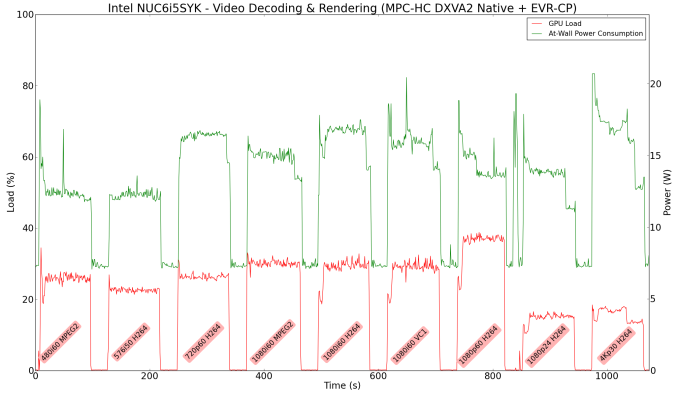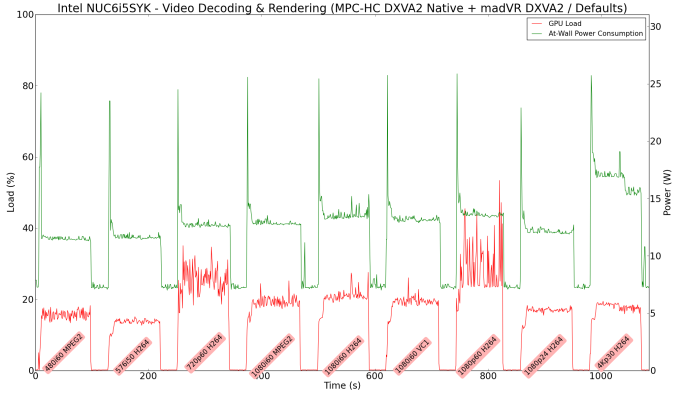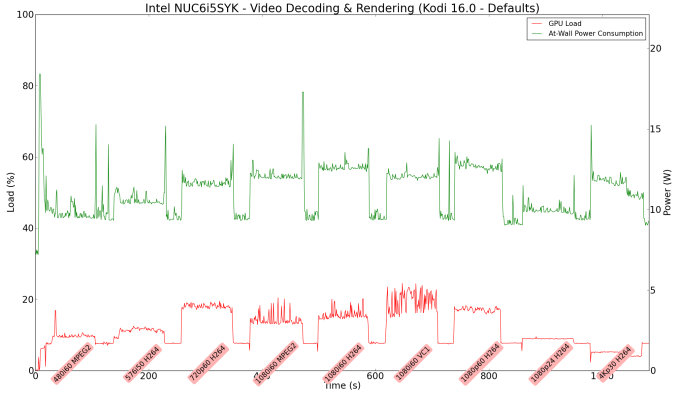The Intel NUC6i5SYK Skylake UCFF PC Review
by Ganesh T S on March 11, 2016 8:00 AM ESTHTPC Credentials
The thermal solution on the NUC6i5SYK is the same as what we have seen in the previous NUCs. Since the Core i5-6260U is a 15W TDP processor, the acoustics are pretty decent (when compared to the fans on the units with 28W TDP processors). Subjectively speaking, the unit is silent for most common HTPC use-cases. Only under heavy CPU / GPU loading (such as stressful madVR configurations) does the fan become audible. Like the previous NUCs, the NUC6i5SYK retains CIR support, enabling use of IR remotes in a home theater setting. The unit definitely makes a good HTPC for folks who don't want to pay the premium for a passively cooled system - however, we didn't find too many improvements over the previous NUCs for HTPC workloads. There is still no HDMI 2.0 / HDCP 2.2 / 4Kp60 HDMI support in the unit.
Refresh Rate Accuracy
Starting with Haswell, Intel, AMD and NVIDIA have been on par with respect to display refresh rate accuracy. The most important refresh rate for videophiles is obviously 23.976 Hz (the 23 Hz setting). As expected, the Intel NUC6i5SYK has no trouble with refreshing the display appropriately in this setting. In fact, the NUC6i5SYK has the most accurate display refresh rates of all the PCs that we have evaluated so far.
The gallery below presents some of the other refresh rates that we tested out. The first statistic in madVR's OSD indicates the display refresh rate.
Network Streaming Efficiency
Evaluation of OTT playback efficiency was done by playing back our standard YouTube test stream and five minutes from our standard Netflix test title. Using HTML5, the YouTube stream plays back a 1080p encoding. Since YouTube now defaults to HTML5 for video playback, we have stopped evaluating Adobe Flash acceleration. Note that only NVIDIA exposes GPU and VPU loads separately. Both Intel and AMD bundle the decoder load along with the GPU load. The following two graphs show the power consumption at the wall for playback of the HTML5 stream in Mozilla Firefox (v 44.0.2).

GPU load was around 24.27% for the YouTube HTML5 stream and barely measurable for the steady state 6 Mbps Netflix streaming case. Note that GPU usage reported by GPU-Z doesn't actually measure the load on the dedicated decoder engines in the GPU.
Netflix streaming evaluation was done using the Windows 10 Netflix app. Manual stream selection is available (Ctrl-Alt-Shift-S) and debug information / statistics can also be viewed (Ctrl-Alt-Shift-D). Statistics collected for the YouTube streaming experiment were also collected here.

Decoding and Rendering Benchmarks
In order to evaluate local file playback, we concentrate on EVR-CP, madVR and Kodi 16.0. We already know that EVR works quite well even with the Intel IGP for our test streams. Under madVR, we used the DXVA2 scaling logic wherever available, and left the rest at default (as it is well known that the stressful configurations don't work even on the Iris Pro-equipped processors). We used the DXVA2 native decoder in the LAV Filters bundled with MPC-HC v1.7.10
In our earlier reviews, we focused on presenting the GPU loading and power consumption at the wall in a table (with problematic streams in bold). Starting with the Broadwell NUC review, we decided to represent the GPU load and power consumption in a graph with dual Y-axes. Nine different test streams of 90 seconds each were played back with a gap of 30 seconds between each of them. The characteristics of each stream are annotated at the bottom of the graph. Note that the GPU usage is graphed in red and needs to be considered against the left axis, while the at-wall power consumption is graphed in green and needs to be considered against the right axis.
Frame drops are evident whenever the GPU load consistently stays above the 85 - 90% mark. The NUC6i5SYK has absolutely no trouble with any of our test streams. Kodi is the most power efficient of the lot, while madVR with DXVA scaling is actually quite power efficient and comparable to EVR-CP.
Moving on to the codec support, the Intel Iris Graphics 540 is a known quantity with respect to the scope of supported hardware accelerated codecs. DXVA Checker serves as a confirmation. Recent driver updates have added VP9 decode support, but, only for 8b encodes.





















95 Comments
View All Comments
CajunArson - Friday, March 11, 2016 - link
Keep in mind that the older i7 NUC is a 28 watt TDP part with a 3.1GHz *base* clock (turbo to 3.4GHz) while this is a 15 watt part with only a 2.9GHz *turbo* maximum clock. It seems to beat the older i5 Broadwell at CPU benchmarks too.MattMe - Friday, March 11, 2016 - link
I've been buying NUCs for desktop replacements at work now for the last year. We have around 40 Broadwell units and so far around 20 Skylake units.I've never experienced any of the issues mentioned in this article, so it's a shame to have what I see as excellent SFF PCs receive a poor review based on that. Understandable, of course.
The only issues we have experienced is the power supplies which are universal, interchangeable plug units. We have had 5 or 6 that have started buzzing and crackling due to arcing on the contact points. A little persuasion with a screwdriver fixes it, but they really let the whole thing down in my opinion.
Otherwise the performance, price, low power and near-silent operation make them perfect office PCs for all except power users and devs. Mounted on the supplied VESA bracket behind the monitor saves a lot of space too. You can set the BIOS to allow power on USB so the users simply press a keyboard key or move the mouse to switch it on in the morning. Perfect.
Zingam - Sunday, March 13, 2016 - link
What type of work is your business? Text editing?TheinsanegamerN - Monday, March 14, 2016 - link
Text editors, powerpoints, excel spreadsheets, web apps, all sorts of stuff business does runs wonderfully on NUCs.We've started using them to drive our POS systems, and our AV systems that broadcast to TVs in our buildings. They work quite well.
8steve8 - Friday, March 11, 2016 - link
No idea why they keep pushing NUCs with 15W cpus, excessively low power for a non-mobile system.the 45W CPU skull canyon is exciting, when should we expect this to launch?
damianrobertjones - Friday, March 11, 2016 - link
...because people buy them? People want them?(I'm sitting in front of one now)
Valantar - Friday, March 11, 2016 - link
If what you want is the tiny NUC form factor, then 15W seems to be spot on. Anything higer would require a very noticeable size increase to help with cooling - unless you're willing to increase noise dramatically, which ... no.Is >30W in a NUC-ish form factor doable, and with low enough noise? Absolutely. Skull Canyon will be intriguing. But it will also undoubtedly be quite a bit larger than the standard NUCs.
8steve8 - Friday, March 11, 2016 - link
yes it would have to be noticeably larger, but still tiny. 45W is a better sweetspot IMO for this kind of SFF PC... and please for skull canyon... please use a regular CPU cooler, and not a noisy blower like gigabyte tried with their brixxx.TheinsanegamerN - Monday, March 14, 2016 - link
It will most likely still be a blower, since the case will most likely be too small for a typical cooler, which needs more space and a different design than what the NUCs use.That being said, intel does a much better job with their blower coolers then gigabyte does.
8steve8 - Monday, March 14, 2016 - link
the intel retail HSF that comes with 65W CPUs is pretty small, yes taller than the NUC blowers, but only by like an inch... no bigger in other dims.Intel may do better than gigabyte with blowers, but gigabyte tried to cool a 65W cpu with a blower, intel is only trying on 5,15 or 28w CPUs... it's easy to be quiet when you are dealing with 15W vs 65W